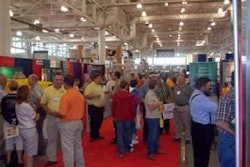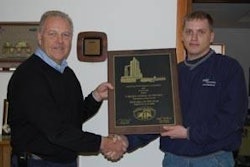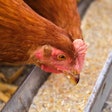
Repeat after me: "Q-three-zero-one hundred!"
You heard it here first, but don't be surprised if these seven syllables from Giddings, Texas, become a mantra heard in Cargill Animal Nutrition feed plants around the world. The central Texas manufacturer of Nutrena and other brand products is a leader among Cargill feed operations stretching across more than 30 countries. As the 2006 Feed Mill of the Year, it is the only plant in the program's 22-year history to win top honors a second time.
For 20 years, Cargill-Giddings has consistently ranked among the top feed plants in North America. In 1989, in full operation only two years, Cargill-Giddings reached the finals of the Feed Mill of the Year Program, and, in 1991, achieved Feed Mill of the Year. Many managers have trained at Giddings and gone on to run other highly successful Cargill feed operations.
By any measure, the Cargill-Giddings team has been doing an outstanding job over two decades, even as the plant's output rose year-on-year, as products became more diverse and complex to manufacture, and as bagged tonnage continued to grow. The ongoing challenge for Giddings plant manager Byron Sommerlatte and more than 30 employees now working three full shifts, six days per week, has been to keep everyone questing for the next level' in safety, quality, customer service, employee engagement, productivity, and efficiency (see tables 'Teams').
Now their new Q3-Zero-100 program 'home-grown from workers' own safety and quality ideas demonstrates the Giddings team's characteristically creative response. A group of South Texas district employees, focused on process improvement, came up with the 'Q3' which stands for "quality people producing quality products and services for quality customers". 'Zero' means zero accidents that is, absolutely zero accidents of any kind, which is a much more demanding goal than zero lost-time accidents. And '100' refers to 100% of employees "fully engaged" in the operation of the plant 100% of the time.
Shifting into 'overdrive' to serve a changing market
Designed and built by Todd & Sargent in 1986, Cargill's new slipform concrete plant north of town replaced an older mill in downtown Giddings. Sommerlatte, assistant plant manager Calvin Patschke, mixing technician Fernando Escalante, and several other Giddings employees recalled running the old plant "flat out" with three shifts. They had "bumped elbows" working in the old plant under the supervision of Sommerlatte and then-plant manager Bob Grimm, who now is retired on a ranch near Giddings. The new Giddings plant allowed Grimm's team of veterans to produce three times as much feed in only two shifts. However, 60-70% of the tonnage was cold-mash layer feed for Cargill's Texas layer operations, which were soon sold to Cal-Maine. When the Cargill-Giddings plant won Feed Mill of the Year in 1991, annual output was less than 100,000 tons. At the time, district general manager John Windwehen explained that the plant would rebuild lost poultry tonnage by increasing commercial feed sales.
Over the next 15 years, Windwehen and his team shifted into 'overdrive' to increase feed sales in surprising directions. By mid-2006, Cargill-Giddings sales tonnage had risen to around 140,000 tons and product mix now affirmed cattle as king': Beef feed products, 49%; horse products, 25%; poultry products for both meat and sport, 10-12%; and deer and other game products, 6-8%. Even more diverse products made up the remaining 6-8% of tonnage, including pelleted shrimp feeds for producers near the Gulf in Texas and Mexico.
Moreover, what had been predominately bulk feed output when the Giddings plant was built, has evolved to 70% bag output. This year, Cargill-Giddings has been floor-stocking more than 140 products, mostly for distribution by contract hauler Harrison Trucking to 275 Nutrena dealers in an area 500 miles east-to-west and 750 miles north-to-south, including transhipment in the Rio Grande valley to Mexican trucks for delivery to Monterrey and other points in Mexico.
Meanwhile, Windwehen had become general manager for Cargill's Central and South Texas district based at Giddings. Sommerlatte, who also started his career at the old Giddings plant in 1980, returned for the new plant start-up in 1986. He subsequently was assigned to several other Cargill facilities but returned to Giddings in 1988, helped to design and build the new plant, and became plant manager.
"Our market has changed significantly since 1991 and continues to change" Sommerlatte told FEED MANAGEMENT. "It means we're making a much more diverse line of products today. We haven't done any structural remodeling of the plant, which says a lot about the original design and construction. But we're constantly changing thingsadding storage and equipment, re-working bagging and warehouse layouts, and so onto adjust our manufacturing to what our customers need."
Cargill-Giddings currently produces pelleted feeds (60% of total tonnage), textured feeds (30%), mash feeds (8%), and pressed blocks (2%) with a variety of equipment (see table Equipment'). A brief history of additions and alterations shows how this Texas team has kept the plant up-to-speed:
- 1991 Pressed block system (Landers) and bag warehouse addition (14,000 square feet);
- 1994 Second (Sprout 200 hp) pelleting line;
- 1995 Ingredient storage (33,000 cubic feet) for low-density products;
- 1997 Second bag palletizer (Inglett);
- 2001 Second hammer mill (Sprout 250 hp) for fine grinding for shrimp feeds, plus additions to shop building and office space;
- 2002 Auto-taggers for bagging lines to print tags on demand;
- 2003 Dry bagging line upgrade from single scale to dual scale (Inglett) and bag hanger (Inglett);
- 2004 Finished feed storage bins for bagging lines (6,400 cubic feet total) and adaptation of bagging lines and downstream conveyors and palletizers for new poly' bags; and
- 2005 Upgraded textured line system with automated Repete controls, expanded break room and office space, and expanded and improved men's and women's restrooms.
"Currently, we get about 21% of our raw materials by rail," Sommerlatte says, "but that is trending up. We're working on a proposal to expand railcar storage track space, which will increase our ingredients purchasing flexibility."
Other recent plant improvements by the Cargill-Giddings crew included installation of electric-actuated hopper valves and bin gates which replaced the original pneumatic units. Also, the crew installed bearing heat sensors and alignment detectors on elevator legs. The hammer mills received heat sensors on bearings and housings and optical spark detectors in the grinding chambers.
Plant improvements pay off in higher 'Q'
Besides greater manufacturing flexibility, Sommerlatte says, Cargill-Giddings plant improvements have paid off in higher quality over a wide range of products. For example, the Giddings plant optimized grinding and screening techniques to pioneer manufacture of 3/32-inch (2.4 mm) shrimp pellets with high immersion integrity, using only conventional single-pass conditioning and ring-die pelleting. The plant became the top shrimp feed manufacturing plant in Texas. Cargill subsequently acquired shrimp feed specialist Burris Mills at Franklinton, Louisiana. Since then, Cargill-Giddings has supplemented the Burris production. But when the Louisiana plant was knocked out briefly last year by Hurricane Katrina, Cargill was able to re-route shrimp feed order entry to the Texas plant, which immediately ramped up production to meet Burris customer needs, both in the USA and abroad.
Another example of upgrading technology and procedures, Sommerlatte notes, has been manufacture of Cargill's Right Now® Minerals products for beef cows. These products are color-coded 'emerald', 'bronze', 'gold', and 'onyx' to match the mineral feeding program to the season, pasture condition, and breeding cycle: "One glance in the feeder and you know that the right mineral is being supplied."
Manufacturing Right Now minerals involves adding molasses and vegetable oil in the main mixer to produce the colored, dust-free, rain-resistant, granular mineral products.
"Consistent color, texture, aroma, and handling are critical quality factors in all our products," Sommerlatte explains, "so we had to get our sequencing and cleanout procedures exactly right for Right Now."
Fines also are a critical concern and the Giddings plant includes a number of aspiration and screening devices to remove loose particles immediately upstream from bagging and bulk loadout. Sommerlatte notes shrimp feed customers require less than 0.5% fines, PDI greater than 99%.
For larger pellets and cubes, getting a good fines measurement can be a challenge, too. At Giddings, and most plants, conventional pellet testing devices such as the KSU 'tumbling can' and others require electric power, typically in a fixed location. The challenge inspired the Cargill-Giddings team to develop their own portable cube and pellet sample fines screener, which can be wheeled to the end of the bagging line or into the warehouse to measure fines in product about to be shipped.
The Giddings plant also pioneered use of the new woven polypropylene bags among Cargill feed plants in North America. The poly bags are less prone to tears and splits than conventional kraft paper bags, which reduces problems in the warehouse, in transport, and at dealer stores. However, Sommerlatte says, to take full advantage of the higher quality bags, the bagging line has to be fine-tuned to handle them efficiently.
Resource use efficiencies up
Results for energy management recorded by Cargill-Giddings showed plant electrical energy efficiency improving steadily year-by-year for the past five years. Efficiency in use of gas also trended up over this period, Sommerlatte reported, as the plant worked hard to counter steeply rising prices.
"We do an annual energy audit which measures our performance against Cargill's Model Mill profile," Sommerlatte explains. "Our power and gas usage is within 5% of the model on a btu-per-ton basis. However, we're focusing on another 3% reduction for the 2006-2007 crop year."
Cargill-Giddings operates a detailed energy management program, developed in collaboration with its power supplier, the Lower Colorado River Authority. Sommerlatte closely manages load demand over the plant's three-shift operation, checking the Giddings 'power meter' and invoices on the LCRA website. The Giddings plant manager also conducts a detailed energy audit once per year, meanwhile overseeing numerous energy conservation activities. For example, twice per year the plant has training on energy conservation, followed up with individual training sessions and discussions with all production employees.
Cargill-Giddings employees have the special responsibility to check for equipment left running empty and other 'energy leaks' throughout the plant on their daily walk-thru. Part of their job is to study the plant for ways to minimize power demand, especially during the peak demand months of June through September, due to the large demand differential. They also pay special attention to the plant's main power-consuming equipmentgrinders, pellet mills, blocking, and packaging lines.
People show pride of place
In a tradition reaching back to its beginnings, Sommerlatte acknowledges, the Giddings plant continues to invest in housekeeping capacity. For example, compressed air is available on overhead hose reels in most parts of the plant, so there must be extra attention to leak detection and prompt repair to aid energy conservation.
"But," the Giddings plant manager adds, "we've got air for cleaning and maintenance wherever and whenever we need itand no hoses underfoot."
FM previously has reported on how original equipment installations at Giddings were designed to promote easy cleaning. Check scales for micro ingredient addition, for example, were mounted off the floor. As Cargill-Giddings has added bag warehouse floor space, it also has upgraded floor cleaning in a big way. A battery-powered rider sweeper was leased to clean large areas while navigating tight spaces between rows of loaded mini-pallets. It is also used to keep the parking lot tidy and clean the truck scale.
"A clean place to work promotes quality all around," notes assistant plant manager Patschke, pointing out the recent additions of a home bathroom-quality women's restroom and a locker room with showers for production technicians. Patschke stands in the recently expanded break room which features large picture windows and walls covered in awards the Giddings plant has received from Cargill Animal Nutrition headquarters and local regional and community organizations. Plaques for Feed Mill of the Year for 1991 and Runner-up Feed Mill of the Year for 1989 hold pride of place. Nearly half of current Cargill-Giddings employees remember those days, while non-supervisory employees average nearly 11 years with the plant.
General manager Windwehen and plant manager Sommerlatte take special pride in the self-starting tradition carried on by the current Cargill-Giddings teamproduction, sales, and administration. The Giddings Pillars Program' enables employees involved in functional teams'for example, production-administration-marketing for a particular line of productsto recognize high performance in the team and reward individuals with a cash award at the end of the month. Management is not part of such decisions, Windwehen says.
"Our operation also is among a select group of Cargill plants which have implemented the One-Plan One-Team' program," Windwehen adds. "This program gives every employee the same options of benefits for medical, dental, life insurance, pension, everything. The program also allows us to reward higher individual performance and we're seeing performance improve overall."
Cargill-Giddings has been especially busy for the past year as the plant temporarily took on tonnage from other Cargill feed mills in the aftermath of Hurricanes Katrina and Rita. There were a number of emergency situations besides the Burris aquafeed plant going off-line. But the Giddings plant kept making feed round-the-clock to keep animals fed all along the Gulf coast and inland hundreds of miles. That output included feed for numerous animal shelters, including emergency arrangements to feed livestock and horses whose owners evacuated.
"Beyond our normal business, thousands more animals were depending on us as their sole source of nourishment," Windwehen recalls. "We got up to speed quickly, but the pace has not slackened since then. We came through with more total business because potential customers saw our product in the field. They saw they could count on our delivery and quality.
"But one thing really sticks in my mind about Giddings over the past year: Not just zero unexcused absences, but zero employee turnover! It points to Byron's management and the whole team's engagement."
Cargill-Giddings' employee engagement extends beyond the plant to ongoing community service activities. These activities include donating all the feed necessary to support the local animal shelter in Giddings, as well as feed donations for 4-H and other non-profit and community animal programs in its territory.
"We can do better!"
Cargill-Giddings' homegrown Q3-Zero-100 program involves everyone on the production floor, in the office, and on the road. It is involving them at home, too, says customer solutions associate Rose Tharp, whose electrician husband used to be the main safety authority around the house. Sommerlatte acknowledges the constant challenge to keep the message of Q3' for quality and safety fresh for all employees. Windwehen adds that Sommerlatte somehow spots at least a couple dozen potential safety and ergonomic risks during every one of his monthly safety audits.
Yet Sommerlatte recalls with chagrin how the Giddings plant had gone more than 1.7 million hours without a lost time accident through 1999. Since then, the plant has gone another 565,000 hours, recording safety status up through the last fiscal year and reporting as required in the 2006 Feed Mill of the Year entry form. Then the unthinkable happened: A production employee skinned the back of his hand on a belt conveyor and required medical care.
"We had a record-setting safety run going," Sommerlatte says ruefully. "But that one slip-up set the safety clock back to zero."
The reference to safety clock' is not figurative. A digital clock commands a place high on the wall of the Giddings break room. Connected to the Cargill intranet, the clock provides a running report, updated minute-by-minute, of the safety status of Cargill Animal Nutrition feed plants worldwide.
"We picked ourselves up and dusted down," Sommerlatte says. "We told ourselves, We can do better!'"
Today, Cargill-Giddings has a work glove policy and program, through which production employees select high quality work gloves designed for their particular jobs. The glove program joins a work boot program and other programs to keep personal safety fresh, quality at optimum level, and all employees 100% engaged at the 2006 Feed Mill of the Year.
Bring it on home now: "Q-three-zero-one hundred!"
















